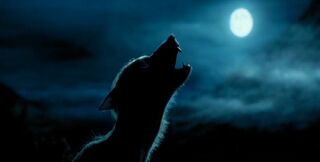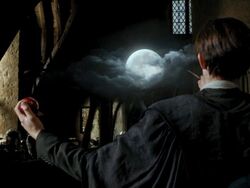- "You have only ever seen me amongst the Order, or under Dumbledore’s protection at Hogwarts! You don’t know how most of the wizarding world sees creatures like me! When they know of my affliction, they can barely talk to me!"
- — Werewolf Remus Lupin on how he is treated because of his condition[src]
A Werewolf is a human who, upon the rising of the full moon, turns into a fearsome near-wolf. Werewolves can be distinguished from regular wolves by several small distinguishing characteristics, such as the pupils of the eyes, snout shape, and tufted tail. At all other times, they appear as normal humans, though will often seem to be ill as the full moon approaches.[1] This condition is caused by infection with lycanthropy, usually occuring when a human is bitten by a transformed werewolf. There is no known cure (however Gilderoy Lockhart claimed he cured a werewolf of its affliction) but the effects can be lessened with a certain potion.
Infection

Remus Lupin in his werewolf form in the spring of 1994.
Lycanthropy is a magical illness known to be spread by saliva-blood contact; thus, a human bitten by a werewolf in wolf form will become a werewolf him or herself. This is what happened to Lupin, who was bitten as a child by Fenrir in retaliation for Remus's father offending the werewolf. However, if a human is bitten by a werewolf in human form, the victim will only acquire some lupine tendencies. For example, Billretained scars and a craving for very rare meat after being attacked by a non-transformed Greyback.[2]
- "My kind don’t usually breed! It will be like me, I am convinced of it – how can I forgive myself, when I knowingly risked passing on my own condition to an innocent child? And if, by some miracle, it is not like me, then it will be better off, a hundred times so, without a father of whom it must always be ashamed!"
- — Remus Lupin on his fear that he would pass lycanthropy on to his then-unborn child[src]
Werewolves seldom have children, so Remus Lupin did not know whether or not his unborn son would inherit his condition but feared that it would be the case. Ted Lupin ultimately proved not to be a werewolf, however.[3]
It seems that werewolves, when in their animal state, may have an affinity with killing the ones closest to them in their normal human form. Example of this is Remus Lupin, when he forgot to take his potion in 1994, just after Peter Pettigrew, who was essentially Harry's parent's murderer, was apprehended. When Lupin transformed, he went after Sirius first, his closest living friend, then knocked Severus Snape aside in an attempt to strike Harry.
Monthly Transformations

Remus Lupin transforming into a werewolf.
- "There was a terrible snarling noise. Lupin's head was lengthening. So was his body. His shoulders were hunching. Hair was sprouting visibly on his face and hands, which were curling into clawed paws."
- — Description of Remus Lupin transforming[src]
On every full moon, a werewolf will go through an incredibly painful transformation from a human into a wolf. They lose the ability to think in a human way, becoming highly aggressive towards humans, even those they are close to. Though werewolves usually only infect their victims through biting, they sometimes take it too far and kill their victims.[2]
Without any humans nearby to attack, or other animals to occupy it, the werewolf will attack itself out of frustration. This leaves many werewolves such as Lupin with self-inflicted scars and prematurely aged from the difficult transformations.[1]
Treatments
Unfortunately, there is no cure for lycanthropy. However, some of the worst effects can be mitigated by consuming Wolfsbane Potion, which allows a werewolf to retain his or her human mind while transformed, thus freeing them from the worry of harming other humans or themselves. Also, frequent users of this potion seem to refrain from transforming until they are in direct contact with the moonlight.[1]
According to Gilderoy Lockhart, the Homorphus Charm can force a werewolf back into human shape. But, since Lockhart is known to have lied many times to inflate his own reputation and implies that the charm cures werewolves, his information is highly suspect — as is the very existance of a Homorphus Charm in the first place.[4]
Attitude towards Werewolves
Prejudice and Discrimination

A diagram of a werewolf in a Defence Against the Dark Arts textbook.
- "Get away from me, werewolf!"
- — Ron Weasley immediately upon learning of Remus Lupin's condition[src]
Werewolves are generally regarded with fear and disgust by wizarding society. It is not uncommon for persons known to be werewolves to be shunned by society and discriminated against within the wizarding world. It is very difficult for a werewolf to get a job in the wizarding community, especially after the passing of restrictive anti-werewolf legislation by the prejudiced Dolores Umbridge in the 1990s.[5] As a result, many werewolves suffer poverty; Remus Lupin managed to get by with the aide of his friend James Potter[6] and later by working as Defence Against the Dark Arts professor at Hogwarts, but was forced to resign from this position after his condition was exposed. Most parents would not want their children being around a werewolf, despite the safety precautions Remus and Albus Dumbledore took.[1]
The Ministry of Magic attempts to regulate werewolves. By 1637, there was a Werewolf Code of Conduct, and according to Newt Scamander, werewolves have been shunted between the Beast and Being divisions of the Department for the Regulation and Control of Magical Creatures for years. At one point, the Werewolf Registry and Werewolf Capture Unit were both in the Beast Division, while at the same time the office for Werewolf Support Services was in the Being Division.
Given Kingsley Shacklebolt's friendship with Remus Lupin and the furthering of Muggle-born and house-elf rights after 1998, it is likely that the reforms of the Ministry under Minister for Magic Shacklebolt included less prejudicial treatment of werewolves.
Retaliation

- "He regards it as his mission in life to bite and to contaminate as many people as possible; he wants to create enough werewolves to overcome the wizards. Voldemort has promised him prey in return for his services. Greyback specializes in children... Bite them young, he says, and raise them away from their parents, raise them to hate normal wizards. Voldemort has threatened to unleash him upon people's sons and daughters; it is a threat that usually produces good results."
- — Remus Lupin on Fenrir Greyback[src]
Due to the oppression and discrimination against werewolves by society, some persons who are werewolves have in turn come to hate their oppressors and, in turn, society in general. These werewolves have organized themselves into their own society. Under Fenrir Greyback's leadership, this society works to infect as many people as possible, especially children, with the goal of one day having enough strength to take control of the wizarding community.

The werewolves under Greyback's command served Lord Voldemort in the Second Wizarding War, though Remus Lupin spied on them for the Order of the Phoenix[2] and the Death Eaters looked down on them; for example, they were not permitted to have the Dark Mark[3]. They were used as a threat to ensure ordinary citizens' compliance with Voldemort; for example, five-year-old Montgomery was fatally attacked by Greyback after his mother refused to cooperate with the Death Eaters.[2] The werewolves under Greyback's command also fought with the Death Eaters in the Battle of the Astronomy Tower and the Battle of Hogwarts.[3]
Known Werewolves

Remus Lupin and his boggart -- the full moon.
- Fenrir Greyback — a leader in the werewolf community and an ally of the Death Eaters
- Remus Lupin — bitten by Fenrir Greyback as a child, member of the Order of the Phoenix
- The Wagga Wagga Werewolf — discussed by Gilderoy Lockhart during his time as Defence Against the Dark Arts Professor at Hogwarts; also discussed in his book Wandering with Werewolves. Lockhart may have invented this individual entirely, but since he often simply took credit for other's deeds, the werewolf itself may have existed, but been defeated by someone else.
- A werewolf on Arthur Weasley's ward during his stay at St Mungo's Hospital for Magical Maladies and Injuries, this new werewolf was assumably befriended by Lupin.
Other Victims of Lycanthropy
- Bill Weasley — attacked by Fenrir Greyback while he was in human form; Bill is not actually a werewolf, although he does have some "wolfish features" (particularly a liking for rare steaks).
Behind the scenes
- Professor Quirinus Quirrell had the first year Defence Against the Dark Arts class copy notes about how to treat werewolf bites. Also, Professor Severus Snape assigned an essay during the 1993-1994 school year when he substituted for Lupin, although werewolves weren't due to be covered until the last chapter of the third-year DADA textbook.
- According to Draco Malfoy and Argus Filch, there are werewolves in the Forbidden Forest, though it is unclear if these are rumours or the truth.
- Tom Marvolo Riddle once accused Rubeus Hagrid of raising "werewolf cubs" under his bed as a youngster, though this was possibly a lie or an exaggeration. It is unknown whether werewolves have cubs (although as werewolves are canines, technically they should be pups, not cubs) or not — Remus Lupin was worried that it might be possible to pass his affliction on his son, but Newton Scamander suggests otherwise. Since Riddle was trying to frame Hagrid, the veracity of his statement is questionable.
- Lord Voldemort referred to werewolf offspring as cubs another time. When at the Malfoy Manor, he ridicules the Malfoys and Bellatrix about the marriage of Remus Lupin and Nymphadora Tonks, asking Draco if he will "babysit the cubs."
- In the Prisoner of Azkaban book the werewolf form is virtually indistinguishable from a true wolf. In the film however, the werewolf form is more similar to the typical movie werewolf which is more human shaped.
Appearances
- Harry Potter and the Philosopher's Stone (First mentioned)
- Harry Potter and the Philosopher's Stone (film) (Mentioned only)
- Harry Potter and the Chamber of Secrets (Mentioned only)
- Harry Potter and the Chamber of Secrets (film) (Mentioned only)
- Harry Potter and the Prisoner of Azkaban (First appearance)
- Harry Potter and the Prisoner of Azkaban (film)
- Harry Potter and the Prisoner of Azkaban (video game)
- Harry Potter and the Order of the Phoenix
- Harry Potter and the Order of the Phoenix (film) (Mentioned only)
- Harry Potter and the Order of the Phoenix (video game)
- Harry Potter and the Half-Blood Prince
- Harry Potter and the Deathly Hallows
- Fantastic Beasts and Where to Find Them
Notes and references
- ↑ 1.0 1.1 1.2 1.3 Harry Potter and the Prisoner of Azkaban'
- ↑ 2.0 2.1 2.2 2.3 Harry Potter and the Half-Blood Prince'
- ↑ 3.0 3.1 3.2 Harry Potter and the Deathly Hallows'
- ↑ Harry Potter and the Chamber of Secrets'
- ↑ Harry Potter and the Order of the Phoenix'
- ↑ J.K. Rowling's Comments at Carnegie Hall
